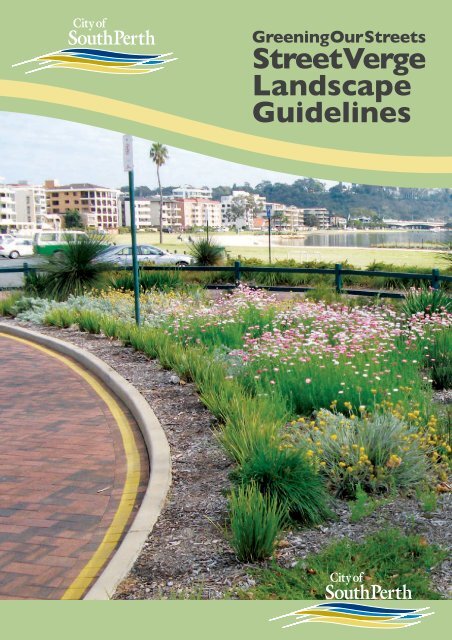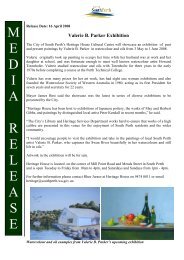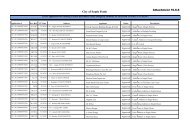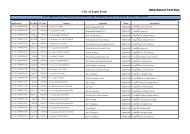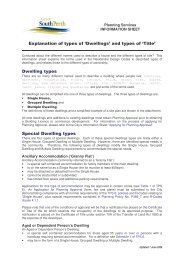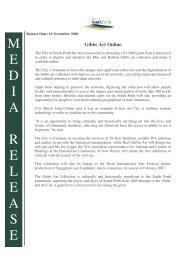Street Verge Landscape Guidelines - City of South Perth
Street Verge Landscape Guidelines - City of South Perth
Street Verge Landscape Guidelines - City of South Perth
Create successful ePaper yourself
Turn your PDF publications into a flip-book with our unique Google optimized e-Paper software.
Greening Our <strong>Street</strong>s<br />
<strong>Street</strong> <strong>Verge</strong><br />
<strong>Landscape</strong><br />
<strong>Guidelines</strong>
Table <strong>of</strong> Contents<br />
What is a street verge? -<br />
Responsibilities and Permissions............................... 3<br />
Greening our <strong>Street</strong>s - Green Plan............................ 4<br />
Caution: Service Locations ........................................ 4<br />
<strong>Street</strong> <strong>Verge</strong> <strong>Landscape</strong> <strong>Guidelines</strong>................... 5 - 14<br />
Lawns, Reticulation and <strong>Verge</strong> Gardens ................................. 5<br />
Planting <strong>Guidelines</strong>..................................................................... 6<br />
Mulching <strong>Guidelines</strong>................................................................... 7<br />
<strong>Verge</strong> Garden Design & Waterwise information......... 8 - 10<br />
Approvals for Paving & Synthetic Turf ........................ 11 - 12<br />
Other Surfaces, Materials and Edging................................... 13<br />
Written Application for Approval to Install<br />
Paving and/or Synthetic Turf to <strong>Verge</strong>................................... 14<br />
Maintaining Your <strong>Street</strong> <strong>Verge</strong>......................... 15 - 16<br />
Plant List – <strong>Verge</strong> Gardens................... centre pullout<br />
GREENING OUR STREETS - <strong>Street</strong> <strong>Verge</strong> <strong>Landscape</strong> <strong>Guidelines</strong> 1
2<br />
GREENING OUR STREETS - <strong>Street</strong> <strong>Verge</strong> Landscaping <strong>Guidelines</strong>
What is a street verge?<br />
A verge is the area <strong>of</strong> land located between a street kerb and boundary <strong>of</strong> an adjacent<br />
property.The verge provides access from the street to private or public properties.<br />
It also accommodates above and below ground public service utilities, such as street<br />
lighting, power, water, sewerage, gas, telephone and optic fbre cables.<br />
Whose responsibility<br />
is the street verge?<br />
The <strong>City</strong> is responsible for the<br />
planting, removal and maintenance<br />
<strong>of</strong> all street trees.<br />
<strong>Verge</strong> landscaping, including natural lawns,<br />
verge gardens, and other treatments, is the<br />
responsibility <strong>of</strong> the householder <strong>of</strong> the<br />
property adjacent to the verge.The <strong>City</strong><br />
encourages residents to take pride in<br />
their verges, to enhance the aesthetic<br />
value <strong>of</strong> their properties and the<br />
streetscape as a whole.<br />
Do I need permission<br />
to landscape my verge?<br />
You do not need permission for:<br />
✔ A natural lawn;<br />
✔ Reticulation;<br />
✔ <strong>Verge</strong>s mulched with organic<br />
mulch; or<br />
✔ Low growing waterwise<br />
verge gardens.<br />
Provided the verge guidelines have<br />
been observed to ensure that your<br />
verge garden will not interfere with<br />
vehicular and pedestrian sightlines<br />
and access.<br />
A waterwise verge garden is strongly<br />
encouraged by the <strong>City</strong>.<br />
You do need permission for<br />
these verge treatments:<br />
• Paving<br />
(i.e. brick and concrete paving etc);<br />
• Synthetic (or artifcial) turf.<br />
A written application to the <strong>City</strong> is<br />
required and approval granted prior<br />
to installation.<br />
The following verge treatments are<br />
not permitted:<br />
✗ Inorganic mulches such as gravel, stone<br />
or crushed brick or rock;<br />
✗ Particular items that protrude above<br />
the natural level <strong>of</strong> the verge.<br />
Refer to the <strong>Street</strong> <strong>Verge</strong> <strong>Landscape</strong><br />
<strong>Guidelines</strong> on page 5 for more information.<br />
Contact us<br />
Civic Centre<br />
cnr Sandgate St & <strong>South</strong> Tce, <strong>South</strong> <strong>Perth</strong><br />
Operations Centre<br />
199 Thelma St, Como<br />
Telephone: 9474 0777<br />
Monday – Friday 8.30am – 5pm<br />
Collier Park Waste Transfer Station<br />
199 Thelma St, Como<br />
Monday - Sunday 9am - 4.45pm<br />
Telephone: 9367 2492<br />
Email: enquiries@southperth.wa.gov.au<br />
Website: www.southperth.wa.gov.au<br />
GREENING OUR STREETS - <strong>Street</strong> <strong>Verge</strong> <strong>Landscape</strong> <strong>Guidelines</strong> 3
4<br />
Greening our <strong>Street</strong>s –<br />
Green Plan<br />
The <strong>City</strong> <strong>of</strong> <strong>South</strong> <strong>Perth</strong> Green Plan<br />
aims to protect, link and enhance public<br />
and private green spaces and biological<br />
resources within the <strong>City</strong>.<br />
Trees play a vital role in providing fauna<br />
corridors between bush sites and in<br />
establishing ecological links.The <strong>City</strong><br />
plants local native species <strong>of</strong> street<br />
and park trees wherever possible.<br />
<strong>Street</strong> trees, natural lawns and verge<br />
gardens reduce storm water run <strong>of</strong>f<br />
which ends up in our rivers and other<br />
waterways. Excess nutrients from<br />
stormwater contributes to unhealthy<br />
water and algal blooms.<br />
Residents can contribute to environmental<br />
links and aid stormwater management by<br />
planting local native plants on their verges<br />
and in their gardens.<br />
GREENING OUR STREETS - <strong>Street</strong> <strong>Verge</strong> <strong>Landscape</strong> <strong>Guidelines</strong><br />
Caution: Service Locations<br />
Before any landscape or excavation work,<br />
call ‘Dial before You Dig’ on 1100 or go to<br />
www.1100.com to fnd ouy the location <strong>of</strong><br />
any below ground services on your verge.<br />
Note - Anyone who installs a verge<br />
treatment <strong>of</strong> any type, or purchases<br />
a property with an already installed<br />
verge treatment, acknowledges<br />
that they:<br />
• Maintain the verge installation so<br />
that all <strong>Street</strong> <strong>Verge</strong> Landscaping<br />
<strong>Guidelines</strong> are met; and<br />
•<br />
Indemnify the <strong>City</strong> <strong>of</strong> <strong>South</strong><br />
<strong>Perth</strong> against any claim or action<br />
whatsoever that may arise as a<br />
result <strong>of</strong> the verge installation.
<strong>Street</strong> <strong>Verge</strong> <strong>Landscape</strong><br />
<strong>Guidelines</strong><br />
These guidelines will help you establish<br />
and maintain your street verge to a<br />
high standard.<br />
The following verge treatments are<br />
permitted without approval from the<br />
<strong>City</strong>, provided the guidelines outlined<br />
are met.<br />
Lawns<br />
• Refer to the brochures Environmental<br />
Guide for the Establishment and<br />
Maintenance <strong>of</strong> Home Lawns and River<br />
Friendly Lawns and Gardens;<br />
• Natural lawns should be kept mown to<br />
the height recommended for that season.<br />
Note - Synthetic turf is not<br />
considered a substitute for natural<br />
lawn, but may be approved as a verge<br />
treatment in particular situations.<br />
Approval is required from the <strong>City</strong><br />
prior to installation. Refer to page 12<br />
for more information.<br />
Reticulation<br />
• Reticulation should be designed to avoid<br />
waste – minimise spray drift outside<br />
the verge area and don’t spray onto<br />
footpaths or roads;<br />
• Sprinklers should be retractable or<br />
‘pop-up’ types;<br />
• Sub-surface and drip irrigation<br />
are recommended.<br />
Low Growing Waterwise<br />
<strong>Verge</strong> Gardens<br />
The establishment and maintenance <strong>of</strong> a<br />
‘waterwise’ low growing verge garden is<br />
encouraged by the <strong>City</strong>.<br />
<strong>Verge</strong> planting with low growing shrubs<br />
and groundcovers is the <strong>City</strong>’s preferred<br />
verge treatment. Low fertiliser and low<br />
water use plants such as local species are<br />
preferred as these will reduce pressure<br />
on our depleting water supply and<br />
aid biodiversity.<br />
Eremophila glabra and fcinia nodosa, Henley St roundabout<br />
GREENING OUR STREETS - <strong>Street</strong> <strong>Verge</strong> <strong>Landscape</strong> <strong>Guidelines</strong> 5
<strong>Verge</strong> Garden<br />
Planting <strong>Guidelines</strong><br />
These guidelines help ensure that the<br />
sightlines and safe access <strong>of</strong> pedestrians<br />
and road users are maintained.<br />
Please follow these guidelines when<br />
planting your verge:<br />
• <strong>Street</strong> trees, including the tree roots,<br />
should be protected and not damaged<br />
during all verge works. If you require<br />
a street tree/s for your verge, please<br />
contact the <strong>City</strong> (see page 3).<br />
6 GREENING OUR STREETS - <strong>Street</strong> <strong>Verge</strong> <strong>Landscape</strong> <strong>Guidelines</strong><br />
• Plants should not interfere with vehicle<br />
or pedestrian sightlines and must be<br />
maintained to a height <strong>of</strong> less than 75cm.<br />
Refer to the Plant List at the back <strong>of</strong><br />
this brochure for plants that naturally<br />
grow to this size, including low growing<br />
groundcovers. Choosing suitable plant<br />
species will minimise the need for<br />
regular pruning.<br />
• Plants should not encroach onto<br />
footpaths or roadways.<br />
• Where a footpath does not exist on<br />
your side <strong>of</strong> the street, a two-metre-wide<br />
unplanted area for pedestrian access<br />
must be maintained along the length <strong>of</strong><br />
the verge at the kerb edge.<br />
• Prickly, thorny,‘spear like’, poisonous,<br />
toxic, or weedy plants should not be<br />
planted on the verge. This includes roses<br />
with thorny stems, yuccas, cacti, and<br />
agaves. Refer to www.weeds.org.au, for<br />
information on plants considered weeds<br />
in <strong>Perth</strong>.<br />
• There should be no holes, stakes<br />
(other than street tree stakes), bollards,<br />
dividers, trip hazards or other physical<br />
barriers that protrude above the level<br />
<strong>of</strong> the verge.<br />
• Areas not planted with lawn must<br />
be mulched with organic mulch, as<br />
this assists in controlling weeds and<br />
maintaining moisture – see next page.
<strong>Verge</strong> Mulching <strong>Guidelines</strong><br />
• Organic mulch (mulch from plants such<br />
as bark mulch) should be installed to all<br />
verge gardens to a minimum depth <strong>of</strong><br />
75mm;<br />
• Mulched verges may be left unplanted,<br />
or planted with a verge garden;<br />
• Use large particled mulch heavy enough<br />
to remain in place and not drift onto<br />
footpaths and roads. It must not contain<br />
sharp or otherwise dangerous material;<br />
• Do not use mulch containing peat<br />
as it retains moisture on the surface<br />
<strong>of</strong> the soil, encouraging shallow root<br />
development and increasing reliance<br />
on irrigation;<br />
• Use seasoned mulch. Do not use ‘green’<br />
mulch that has too recently been<br />
produced, as it causes draw down <strong>of</strong><br />
nutrients which adversely affects plants,<br />
and it <strong>of</strong>ten has undesirable seeds that<br />
may germinate;<br />
• The fnished level should be no higher<br />
than the surrounding top <strong>of</strong> kerb and<br />
footpath heights. This may require<br />
some soil removal in preparation for<br />
your garden.<br />
Mulch is available for <strong>City</strong> residents<br />
only. It can be obtained from the<br />
Collier Park Waste Transfer Station<br />
(see page 3).<br />
GREENING OUR STREETS - <strong>Street</strong> <strong>Verge</strong> <strong>Landscape</strong> <strong>Guidelines</strong> 7
STREET<br />
m<br />
ccess edge<br />
ontinues<br />
Flush (level with verge) edge divider between lawn &<br />
mulch; more than 3 metres from street tree<br />
Plan <strong>of</strong> Large <strong>Verge</strong> With Footpath<br />
adjacent to street kerb<br />
(as no footpath)<br />
Mulch only<br />
(alternative is lawn)<br />
<strong>Verge</strong> Garden Design Tips<br />
• Plan your garden on paper as a<br />
DRIVE<br />
FRONT GARDEN<br />
sketched plan so that you know<br />
Flush (level with verge) edge divider<br />
between • Consider lawn & the mulch; various more than forms <strong>of</strong> the<br />
3 metres from street tree<br />
plants – to aid sightlines, place<br />
what plants to acquire;<br />
FOOTPATH<br />
• If you wish to include an edge or divider<br />
DRIVEbetween<br />
components <strong>of</strong> your verge<br />
CROSSOVER garden, or the adjacent property’s verge,<br />
use the guidelines under ‘Other Surfaces,<br />
groundcovers adjacent to footpaths and/<br />
or the two metre access edge along the<br />
verge, and low shrubs and strappy/grassy<br />
plants elsewhere; VERGE GARDEN <strong>of</strong><br />
shrubs & groundcovers<br />
• Consider plant formless and than colour 75cm tall and tie<br />
Materials and Edging’ (see page 13);<br />
these in with your property’s materials<br />
• Choose plants suited to the site’s<br />
EET<br />
environmental conditions – group plants<br />
with similar water/ fertiliser/ shade/and<br />
Groundcovers planted 1.5m in<br />
sun from requirements;<br />
edges at 2m spacings<br />
Low shrubs (x7)<br />
pprox. 16 plants depending on species)<br />
• Mass plant the same species for<br />
and the remainder <strong>of</strong> your garden;<br />
• Consider ‘lawn alternatives’ – mass plant<br />
Mulch only around<br />
low growing tree trunks, groundcovers or <strong>of</strong> one or two<br />
species add to tufty/ create grassy an alternative ‘green<br />
carpet’ to plants the verge. also<br />
increased effect as well as ease STREET <strong>of</strong> TREES (x2) The following are samples <strong>of</strong> sketch plans<br />
maintenance. A simple scheme <strong>of</strong> two <strong>of</strong> street verge gardens that would meet<br />
or three species on a verge can be a<br />
very attractive option;<br />
the planting guidelines outlined.<br />
VERGE<br />
Plan Plan <strong>of</strong> Small <strong>of</strong> Small <strong>Verge</strong> <strong>Verge</strong> With With Footpath Footpath<br />
KERB<br />
PROPERTY<br />
BOUNDARY<br />
FOOTPATH<br />
DRIVE<br />
CROSSOVER<br />
STREET<br />
Lot is approximately 12m wide<br />
with a 4m wide driveway<br />
FRONT GARDEN<br />
STREET TREE<br />
n Lancaster, 8<br />
GREENING <strong>City</strong> OUR <strong>of</strong> <strong>South</strong> STREETS <strong>Perth</strong>, - <strong>Street</strong> 2011<strong>Verge</strong><br />
<strong>Landscape</strong> <strong>Guidelines</strong><br />
VERGE GARDEN<br />
less than 75cm tall<br />
<strong>of</strong> low groundcovers (x6)<br />
& strappy plants (x9-12)<br />
in organic mulch<br />
Neighbour’s verge continues<br />
the planting theme
PROPERTY<br />
BOUNDARY<br />
VERGE<br />
GE<br />
KERB<br />
PROPERTY PROPERTY<br />
BOUNDARY<br />
DRIVE<br />
BOUNDARY<br />
VERGE<br />
LAWN<br />
DRIVE<br />
DRIVE<br />
CROSSOVER<br />
STREET<br />
STREET<br />
Plan <strong>of</strong> <strong>Verge</strong> Without Footpath<br />
Plan <strong>of</strong> <strong>Verge</strong> Without Footpath<br />
Plan <strong>of</strong> <strong>Verge</strong> Without Footpath<br />
Lot is approximately 20m wide<br />
Lot is approximately 20m wide<br />
DRIVE DRIVE<br />
CROSSOVER CROSSOVER<br />
VERGE<br />
LAWN &<br />
LAWN<br />
GARDEN<br />
& GARDEN<br />
DRIVE<br />
KERB<br />
2m<br />
STREET TREE<br />
KERB<br />
STREET TREE<br />
STREET<br />
STREET 2m<br />
Flush (level with verge) edge divider between lawn &<br />
access edge Flush (level mulch; with more verge) than edge 3 metres divider from between street tree lawn &<br />
access edge continues<br />
continues<br />
mulch; more than 3 metres from street tree<br />
PROPERTY<br />
BOUNDARY<br />
KERB<br />
Plan <strong>of</strong> Large <strong>Verge</strong> With Footpath<br />
Plan <strong>of</strong> Large <strong>Verge</strong> With Footpath<br />
LAWN<br />
Groundcovers planted 1.5m in<br />
from edges at 2m spacings<br />
(approx. 16 plants depending on species)<br />
Flush (level with verge) edge divider<br />
between lawn & mulch; more than<br />
FRONT GARDEN 3 metres from street tree<br />
Flush (level with verge) edge divider<br />
between lawn & mulch; more than<br />
FOOTPATH<br />
FRONT GARDEN 3 metres from street tree<br />
FOOTPATH<br />
VERGE GARDEN <strong>of</strong><br />
shrubs & groundcovers<br />
less than 75cm tall<br />
Mulch only around<br />
tree trunks, or<br />
Low shrubs (x7) add tufty/ grassy<br />
plants also<br />
Mulch only around<br />
STREET TREES (x2)<br />
tree trunks, or<br />
Low shrubs (x7) add tufty/ grassy<br />
<strong>Verge</strong> plans by Karen Lancaster, plants also <strong>City</strong> <strong>of</strong> <strong>South</strong> <strong>Perth</strong>, 2011<br />
STREET TREES (x2)<br />
Plan <strong>of</strong> Small <strong>Verge</strong> With Footpath<br />
PROPERTY<br />
BOUNDARY<br />
FRONT GARDEN<br />
GREENING OUR STREETS - <strong>Street</strong> <strong>Verge</strong> <strong>Landscape</strong> <strong>Guidelines</strong> 9<br />
STREET TREE<br />
VERGE GARDEN<br />
Plan <strong>of</strong> Small FOOTPATH <strong>Verge</strong> With Footpath<br />
VERGE<br />
HOUSE<br />
HOUSE<br />
Plan <strong>of</strong> Large <strong>Verge</strong> With Footpath<br />
DRIVE<br />
DRIVE<br />
CROSSOVER<br />
Groundcovers planted 1.5m in<br />
from edges at 2m spacings<br />
(approx. 16 plants depending on species)<br />
VERGE GARDEN <strong>of</strong><br />
shrubs & groundcovers<br />
less less than 75cm tall<br />
continues out from<br />
private garden<br />
private garden<br />
2 metre wide<br />
2 PEDESTRIAN metre wide ACCESS<br />
PEDESTRIAN adjacent to street ACCESS kerb<br />
adjacent (as no footpath) to street kerb<br />
(as Mulch no footpath) only<br />
Mulch (alternative only is lawn)<br />
(alternative is lawn)<br />
VERGE GARDEN <strong>of</strong><br />
shrubs & groundcovers<br />
less than 75cm tall
Where can I see a waterwise<br />
garden and get waterwise<br />
plant information?<br />
Many <strong>of</strong> our reserves and gardens have The Water Corporation and Great<br />
waterwise plants on display which are Gardens websites provide information<br />
suitable for verges and home gardens.The on waterwise plants for <strong>Perth</strong> at:<br />
<strong>City</strong> will install a number <strong>of</strong> demonstration<br />
verge gardens in the near future.<br />
• www.watercorporation.com.au/w/<br />
waterwise_plants_perth.cfm<br />
Some suggested waterwise verge plants<br />
are listed in the Plant List at the back <strong>of</strong><br />
• www.greatgardens.info<br />
this brochure, or contact your local plant<br />
nursery or a landscaper for information.<br />
• www.beyondgardens.com.au<br />
10 GREENING OUR STREETS - <strong>Street</strong> <strong>Verge</strong> <strong>Landscape</strong> <strong>Guidelines</strong>
Approval for Paving or Other<br />
Hardstand and/or Synthetic Turf<br />
Trees can be severely damaged by soil<br />
compaction, damage to their roots,<br />
‘collar rot’ and lack <strong>of</strong> water and<br />
nutrients. Our street trees are a valuable<br />
asset that need to be protected. Refer to<br />
the brochure ‘Caring for Our <strong>Street</strong> Trees’<br />
on the <strong>City</strong>’s website (see page 3) for<br />
more information.<br />
In order to protect our street trees, and<br />
aid stormwater management, the following<br />
verge treatments require individual<br />
assessment by the <strong>City</strong>.<br />
These treatments require a<br />
written application to the <strong>City</strong>.<br />
They must NOT be installed<br />
PRIOR to receiving written<br />
approval by the <strong>City</strong>.<br />
Paving<br />
• Public amenity and streetscape<br />
aesthetic will be taken into account<br />
as part <strong>of</strong> each assessment.<br />
• Paved areas should not provide<br />
formal verge parking, unless approved<br />
in writing by the <strong>City</strong>.<br />
• <strong>Verge</strong>s cannot consist <strong>of</strong> more<br />
than 50 per cent <strong>of</strong> hardstand area.<br />
This includes driveway crossovers +<br />
footpaths + all hardstand materials<br />
including concrete, asphalt, paving, and<br />
synthetic turf.<br />
(The exception is for verges <strong>of</strong> less than<br />
1.5 metres wide, not including the width<br />
<strong>of</strong> the footpath; and isolated remnant<br />
portions <strong>of</strong> verge less than 6m 2 ; where<br />
it is not practical to maintain a natural<br />
lawn or garden).<br />
• Pavers used on the verge must be<br />
heavy duty and at least 60mm thick.<br />
• Small format pavers (for example<br />
cobblestones, brick sized pavers<br />
and pavers up to 300 x 300mm) are<br />
preferred, as they have a higher level<br />
<strong>of</strong> permeability than larger format<br />
paving, allowing for better drainage<br />
and water permeation. Porous pavers<br />
are strongly encouraged.<br />
• If a property adjoins two<br />
streets, each street verge will<br />
be considered independently.<br />
• A minimum <strong>of</strong> 3m, depending on the tree<br />
species and size*, is required between the<br />
trunk <strong>of</strong> a street tree and the installation<br />
<strong>of</strong> paving.<br />
• Installation <strong>of</strong> pavers and other materials<br />
should be to the required standard <strong>of</strong> the<br />
<strong>City</strong>; including compacted sub base and<br />
properly retained edges.<br />
* The ‘Tree Protection Zone’ (TPZ) for your street<br />
tree will be assessed by the <strong>City</strong> as part <strong>of</strong> the<br />
application process.<br />
GREENING OUR STREETS - <strong>Street</strong> <strong>Verge</strong> <strong>Landscape</strong> <strong>Guidelines</strong> 11
Synthetic Turf<br />
• Public amenity and streetscape aesthetic<br />
will be taken into account as part <strong>of</strong><br />
each assessment.<br />
• <strong>Verge</strong>s should not consist <strong>of</strong> more than<br />
50 per cent <strong>of</strong> hardstand area. Due to<br />
the hardstand nature <strong>of</strong> the compacted<br />
sub base required for synthetic turf, the<br />
total area <strong>of</strong> synthetic turf + all hardstand<br />
(including crossovers, footpaths, asphalt<br />
and paving) should not cover more than<br />
50 per cent <strong>of</strong> the verge.<br />
• The exception is for verges <strong>of</strong> less than<br />
1.5m wide, not including the width <strong>of</strong><br />
footpath; and isolated remnant portions<br />
12 GREENING OUR STREETS - <strong>Street</strong> <strong>Verge</strong> <strong>Landscape</strong> <strong>Guidelines</strong><br />
<strong>of</strong> verge less than 6m 2 ; where it is not<br />
practical to maintain a natural lawn<br />
or garden.<br />
• If a property adjoins two streets,<br />
each street verge will be<br />
considered independently.<br />
• A minimum <strong>of</strong> 3m, depending on the tree<br />
species and size*, is required between the<br />
trunk <strong>of</strong> a street tree and the installation<br />
<strong>of</strong> synthetic turf.<br />
• The supply and installation <strong>of</strong> synthetic<br />
turf must be to the required standard<br />
<strong>of</strong> the <strong>City</strong>.<br />
* The ‘Tree Protection Zone’ (TPZ) for your street<br />
tree will be assessed by the <strong>City</strong> as part <strong>of</strong> the<br />
application process.
Other Surfaces, Materials<br />
and Edging<br />
Other Surfaces and Materials<br />
NOT PERMITTED<br />
✗ Inorganic mulches such as pea gravel,<br />
gravel or other stone aggregates,<br />
crushed brick or rock are not suitable<br />
as surface treatment for verges.<br />
✗ Kerbing, rocks and other elements<br />
including bollards, decorative items and<br />
garden ornaments that protrude above<br />
the natural level <strong>of</strong> the verge, and<br />
physical barriers.<br />
Edgings<br />
PERMITTED as a component <strong>of</strong> a<br />
permissible verge garden, without<br />
written approval from the <strong>City</strong>:<br />
✔ Edgings and dividers on verges or<br />
between verges, only to the extent<br />
required to provide suffcient division,<br />
provided they are:<br />
1. Flush with the verge surface,<br />
footpath and the top <strong>of</strong> the kerb; and<br />
2. At least 3m from a street tree; and<br />
3. Constructed <strong>of</strong> fush concrete<br />
kerbing (not raised extruded<br />
kerbing), a minimum thickness <strong>of</strong><br />
100mm, or bricks or traffcable<br />
pavers, which are securely fxed,<br />
for example laid on concrete.<br />
GREENING OUR STREETS - <strong>Street</strong> <strong>Verge</strong> <strong>Landscape</strong> <strong>Guidelines</strong> 13
Written Application for<br />
Approval to Install Paving<br />
and/or Synthetic Turf to <strong>Verge</strong><br />
The written application must include:<br />
• A scaled plan at 1:100 <strong>of</strong> the proposed<br />
verge treatment/s, including –<br />
• Relevant or existing features such as<br />
street trees and driveways/crossovers,<br />
all clearly labelled;<br />
• Distances between features must be<br />
shown, for example,‘2.2m street tree<br />
to edge <strong>of</strong> driveway’;<br />
• Details <strong>of</strong> installation for hardstand<br />
areas; including materials (paver/<br />
synthetic turf type), sub base and edge<br />
retention;<br />
• Where the installation also includes<br />
a verge garden or lawn;<br />
• A list <strong>of</strong> plants to be used, using<br />
botanical names; and<br />
• Proposed or existing irrigation systems.<br />
Application Forms are available from the<br />
<strong>City</strong>’s administration <strong>of</strong>fce (see page 3).<br />
14 GREENING OUR STREETS - <strong>Street</strong> <strong>Verge</strong> <strong>Landscape</strong> <strong>Guidelines</strong><br />
An Administration Fee will be incurred for<br />
processing the application and inspecting<br />
the verge.<br />
Approval will be subject to the conditions<br />
that the <strong>City</strong> considers appropriate.<br />
Public amenity and streetscape aesthetic<br />
will be taken into account as part <strong>of</strong><br />
each assessment.<br />
If verge treatments that require approval<br />
are installed without <strong>City</strong> approval, the<br />
<strong>City</strong> may require they be amended or<br />
removed entirely, with the cost incurred<br />
by the resident.<br />
Applications are to be submitted to:<br />
Director, Infrastructure Services<br />
<strong>City</strong> <strong>of</strong> <strong>South</strong> <strong>Perth</strong><br />
Cnr Sandgate St and <strong>South</strong> Tce<br />
<strong>South</strong> <strong>Perth</strong> WA 6151
Maintaining Your <strong>Street</strong> <strong>Verge</strong><br />
<strong>Street</strong> Trees<br />
The <strong>City</strong> undertakes all street tree care<br />
as part <strong>of</strong> its maintenance program and<br />
keeps records <strong>of</strong> all <strong>of</strong> the 17,000 plus<br />
trees in the <strong>City</strong>. It is an <strong>of</strong>fence for anyone<br />
else to prune or remove a street tree.<br />
If you require a street tree/s for your<br />
verge, please contact the <strong>City</strong>. For more<br />
information, refer to the <strong>City</strong>’s ‘Caring for<br />
our <strong>Street</strong> Trees’ brochure on the <strong>City</strong>’s<br />
website (see page 3).<br />
Access and Sightlines:<br />
Footpaths and Roads<br />
• In order to maintain access and sightlines<br />
to footpaths and roads, all plants and<br />
tree branches encroaching from private<br />
properties and verge gardens need to be<br />
regularly trimmed.<br />
• Any faults or damage to footpaths should<br />
be reported to the <strong>City</strong>.<br />
Chemicals and Fertilisers<br />
• To minimise over fertilising, fertilisers<br />
should only be applied when symptoms<br />
<strong>of</strong> nutrient defciency occur, such as<br />
yellowing. Local native plants require less<br />
fertiliser than introduced plants as they<br />
are adapted to our low nutrient soils.<br />
• Fertilise in spring or autumn, as summer<br />
fertilising increases water use, and<br />
fertiliser applied during winter may<br />
be washed into stormwater drains or<br />
leached into groundwater.<br />
For more information on fertiliser use<br />
please visit www.fertilisewise.org.au<br />
• Weed, pest and disease control should<br />
be dealt with using physical non-toxic<br />
means, rather than relying solely upon<br />
chemical control.<br />
• Only chemicals such as herbicides<br />
or pesticides approved for use in the<br />
domestic garden may be used.<br />
• Caution should be applied during<br />
application, with manufacturer’s<br />
directions followed. Targeted application<br />
is required, with a preference for wiping,<br />
brushing or hand held spraying.<br />
• You may request the <strong>City</strong> not to spray<br />
your kerb or footpath during the <strong>City</strong>’s<br />
street maintenance program.<br />
GREENING OUR STREETS - <strong>Street</strong> <strong>Verge</strong> <strong>Landscape</strong> <strong>Guidelines</strong> 15
16 GREENING OUR STREETS - <strong>Street</strong> <strong>Verge</strong> <strong>Landscape</strong> <strong>Guidelines</strong><br />
Levels and Trip Hazards<br />
• The level and grade <strong>of</strong> a verge should<br />
remain consistent with the surrounding<br />
levels. Edging and dividing materials, and<br />
service pits should remain level with<br />
the ground.<br />
• There should be no holes, stakes (other<br />
than street tree stakes) or trip hazards,<br />
including bollards and physical barriers<br />
on your verge.<br />
<strong>Verge</strong> Works and<br />
Service Maintenance<br />
• When carrying out verge works, to<br />
reduce the risk to yourself, pedestrians<br />
and road users, safety precautions must<br />
be taken.<br />
• Please remember that service providers,<br />
including the <strong>City</strong>, retain the right to<br />
access the verge for service maintenance<br />
works that may disrupt or damage verge<br />
gardens and other verge treatments.<br />
Reinstatement is generally at the cost<br />
<strong>of</strong> the land owner.<br />
If You Are Building –<br />
<strong>Verge</strong> Licences<br />
No materials are to be stored on the<br />
verge without a <strong>Verge</strong> Licence.<strong>Verge</strong><br />
licences can be obtained from the <strong>City</strong><br />
(see page 3). Refer to Form <strong>of</strong> Application<br />
for <strong>Verge</strong> Treatment Approval on the <strong>City</strong>’s<br />
website (see page 3).
Plant List – <strong>Verge</strong> Gardens<br />
Some suggested waterwise plants that generally grow less than 75cm tall.<br />
However, growth habits <strong>of</strong> plants will vary with soil condition and watering,<br />
therefore some may require pruning to remain below the required 75cm height.<br />
Grassy and Strappy Plants<br />
Botanical Name<br />
Common Name Growth Rate Comments<br />
Anigozanthos humilis Cats Paw Small Clumping to 45cm tall Brilliant yellow, red and orange paw fowers in<br />
spring. A fantastic perennial plant that attracts<br />
honeyeater birds.<br />
Lime tolerant.<br />
Anigozanthos ssp. Kangaroo Paws Choose the lower growing varieties up<br />
to 75cm tall<br />
Many cultivars including dwarf growing hybrids<br />
<strong>of</strong> various fower colours. Make good cut fowers.<br />
Best grown in full sun.<br />
Conostylis candicans Grey Cottonheads Tufted to 30cm tall by 50cm spread A lovely grass-like plant with grey foliage<br />
and bright yellow bobble fower heads.<br />
Dianella revoluta dwarf – (e.g.’ Little Rev’) Blueberry Lily dwarf Clumping fax-like plant – choose dwarf varieties This tufted plant has a growth form similar<br />
to faxes.<br />
Important for the native blue-banded bee.<br />
Ficinia nodosa Knotted Club Rush Small Rush to 70cm tall by 50cm to 1m wide Dark green cylindrical leaves. Pruning is effective.<br />
Has a tendency to spread rapidly by seed.<br />
Orthrosanthus laxus / multiforus Morning Iris Clumping Plant – to 50cm high and 50 –<br />
100cm wide<br />
Attractive blue fowers from August to November.<br />
Mass plant for good effect.<br />
Patersonia occidentalis Purple Flag Clumping Plant to 60cm tall Local tufted perennial that produces blue, purple<br />
or violet fowers spring and summer.<br />
Thysanotus multiforus Fringe Lily Clumping Plant to 50cm tall by 30cm Attractive herb with a fat bladed leaf and delicate<br />
mauve purple fowers spring to early summer.<br />
Photos for Anigozanthos humilis, Orthrosanthus laxus / multiforus, Patersonia occidentalis,Thysanotus multiforus, Banksia petiolaris, Enchylaena tomentosa © www.plantsman.com.au<br />
Groundcovers<br />
Botanical Name Common Name Growth Rate Comments<br />
Banksia blechnifolia <strong>South</strong>ern Blechnum Prostrate plant Pale woolly orange<br />
Banksia<br />
25–45cm tall by Banksia fowers at<br />
1–3m spread ground level late<br />
winter to spring.<br />
Very hardy.<br />
Banksia petiolaris Petiolaris Banksia /<br />
Creeping Banksia /<br />
Prostrate Banksia<br />
Calothamnus<br />
quadrifdus prostrate<br />
Prostrate Netbush<br />
/ One-sided<br />
Bottlebrush<br />
Prostrate plant to<br />
1m spread<br />
Prostrate to 60cm tall<br />
by 2m spread<br />
Dampiera linearis Common Dampiera Groundcover 15cm<br />
to 60cm tall<br />
Enchylaena tomentosa Barrier Saltbush /<br />
Ruby Saltbush<br />
Eremophila<br />
glabra prostrate<br />
Tar Bush / Emu Bush<br />
e.g. Kalbarri Carpet<br />
Spreading<br />
groundcover 10cm<br />
to 60cm tall<br />
Prostrate to 20cm<br />
groundcover to<br />
1m spread<br />
Ornamental toothed<br />
leaves with reddishpink<br />
new growth<br />
Large yellow<br />
fower spikes.<br />
Quick growing, bird<br />
attracting, red fowers<br />
in spring and summer.<br />
Wedge-shaped leaves<br />
and attractive blue<br />
fowers. Can be grown<br />
alongside non-native<br />
plants to great effect.<br />
Attractive blue-grey<br />
foliage produces<br />
berries that attract<br />
many types <strong>of</strong><br />
honeyeaters. Effective<br />
at excluding weeds<br />
once established.<br />
Attractive silver<br />
foliage. Yellow /<br />
Orange fowers that<br />
attract small birds.
Groundcovers continued<br />
Botanical Name Common Name Growth Rate Comments<br />
Frankenia paucifora Sea Heath Less than 45cm high Tolerant <strong>of</strong> saline<br />
and 50cm wide conditions. Lovely<br />
pink/white fowers<br />
from July to February.<br />
Grevillea curviloba ssp. Narrow Curved Low growing – 3m Light green leaves<br />
Incurva prostrate Leaf Grevillea spread **ensure with perfumed<br />
groundcover groundcover variety white spider fower<br />
in spring. Rapid<br />
growing in a moist<br />
well drained soil in<br />
full sun.<br />
Grevillea obtusifolia<br />
Gingin Gem<br />
Gingin Gem Grevillea Dense low<br />
groundcover to<br />
3m spread<br />
Good lawn<br />
substitute – low<br />
dense fast growing<br />
hardy green<br />
groundcover<br />
with small pinkish<br />
spider fowers in<br />
winter/spring.<br />
Hemiandra Snake Bush Groundcover Bird attracting<br />
pungens glabra 2-3m spread mauve/ pink or white<br />
fowers in spring.<br />
Kennedia prostrata Running Postman Ground Creeper Attractive prostrate<br />
to 2.5m spread groundcover with<br />
red fowers. May<br />
need to be replaced<br />
every couple <strong>of</strong> years.<br />
Photos for Frankenia paucifora, Grevillea curviloba ssp. Incurva prostrate, Eremaea paucifora, Philotheca spicata © www.plantsman.com.au<br />
Botanical Name<br />
Shrubs<br />
Common Name Growth Rate Comments<br />
Adenanthos cuneatus Coastal Jugfower Select compact/ groundcover eg. Coral Carpet<br />
to 50cm tall by similar width<br />
Silver green foliage with interesting pink/red/pale green new growth.<br />
Small purple pink fowers provide nectar for honey eating birds.<br />
Banksia/Dryandra nivea Couch Honeypot Ground cover / low shrub to 50cm tall Attractive foliage and interesting ‘honeypot’ fowers. Can be slow to<br />
establish, but is very attractive to many native insects and small birds.<br />
Chrysocephalum baxteri Paper Daisy, Everlasting Less than 45cm tall by 50cm wide Long lasting white daisy fowers with a yellow centre, are produced<br />
from late spring to early autumn.<br />
Eremaea paucifora Orange<br />
fowered eremea<br />
Grevillea<br />
crithmifolia prostrate<br />
Grevillea preissii<br />
‘Seaspray’/ ‘Gilt Dragon’<br />
Crithmifolia<br />
Grevillea prostrate<br />
Seaspray Grevillea/Gilt<br />
Dragon Grevillea<br />
Grevillea ssp Various species<br />
<strong>of</strong> Grevillea<br />
Small erect shrub from 30cm tall Stunning bright orange feather fowers spring to summer.<br />
Low growing – 3m spread **ensure<br />
prostrate variety<br />
Aromatic white fowers from winter to spring on a green<br />
carpet <strong>of</strong> very dense low growing shrub. Quick growing.<br />
Small shrub to 70cm tall and similar width S<strong>of</strong>t grey green foliage and small red fowers. Fast growing.<br />
Groundcovers and low shrubs to 75cm tall Various species <strong>of</strong> Grevillea in addition to those listed above<br />
are available that suit verge planting.<br />
Hibbertia racemosa Stalked Guinea Flower Small Shrub to 50cm tall and wide Bright yellow fowers winter to early summer.<br />
Leschenaultia foribunda Free-fowering<br />
Leschenaultia<br />
Leucophyta brownii Silver Nugget or<br />
Dwarf Cushion Bush<br />
Melaleuca incana nana Dwarf Grey<br />
Honey Myrtle<br />
Small Shrub to 60cm high x 80cm Attractive small shrub with blue to purple fowers.<br />
Looks very effective in group plantings.<br />
Dense small shrub - choose compact dwarf forms Silver leaves with inconspicuous yellow fowers in summer.<br />
Small shrub – less than 45 cm high and 50–100cm<br />
wide **ensure dwarf variety<br />
A dwarf form <strong>of</strong> the species that forms a dense round<br />
dome <strong>of</strong> grey green slightly weeping foliage.<br />
Philotheca spicata Pepper and Salt Shrub < 45cm high and 50–100cm wide Small branching, sprawling shrub with slender leaves and<br />
pink mauve star fowers in spring.Tolerates reasonable shade.<br />
Scaevola varieties Fan-Flower Less than 45cm high and 50cm wide A number <strong>of</strong> varieties <strong>of</strong> this native plant have been developed.<br />
Attractive deep blue, purple or white fowers.<br />
Plant List Pull Out


